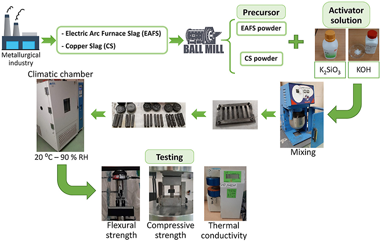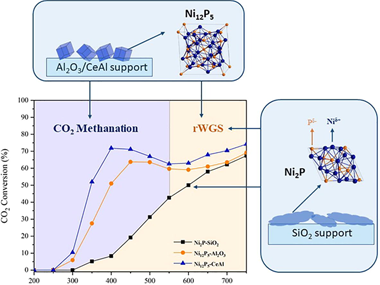Scientific Papers in SCI
2022
2022
Nanotecnología en Superficies y Plasma
Design and Characterization of ITO-Covered Resonant Nanopillars for Dual Optical and Electrochemical Sensing
Tramarin, L; Casquel, R; Gil-Rostra, J; Gonzalez-Martinez, MA; Herrero-Labrador, R; Murillo, AMM; Laguna, MF; Banuls, MJ; Gonzalez-Elipe, AR; Holgado, MChemosensors, 10 (2022) 393
Show abstract ▽
In this work we present a dual optical and electrochemical sensor based on SiO2/Si3N4 resonant nanopillars covered with an indium tin oxide (ITO) thin film. A 25-30 nm thick ITO layer deposited by magnetron sputtering acts as an electrode when incorporated onto the nanostructured array, without compromising the optical sensing capability of the nanopillars. Bulk sensing performances before and after ITO deposition have been measured and compared in accordance with theoretical calculations. The electrochemical activity has been determined by the ferri/ferrocyanide redox reaction, showing a remarkably higher activity than that of flat thin films of similar ITO nominal thickness, and proving that the nanopillar system covered by ITO presents electrical continuity. A label-free optical biological detection has been performed, where the presence of amyloid-beta has been detected through an immunoassay enhanced with gold nanoparticles. Again, the experimental results have been corroborated by theoretical simulations. We have demonstrated that ITO can be a beneficial component for resonant nanopillars sensors by adding potential electrochemical sensing capabilities, without significantly altering their optical properties. We foresee that resonant nanopillars coated with a continuous ITO film could be used for simultaneous optical and electrochemical biosensing, improving the robustness of biomolecular identification.
October, 2022 | DOI: 10.3390/chemosensors10100393
Reactividad de Sólidos
Comparative study of alkali activated cements based on metallurgical slags, in terms of technological properties developed
Gomez-Casero, MA; Perez-Villarejo, L; Sanchez-Soto, PJ; Eliche-Quesada, DSustainable Chemistry and Pharmacy, 29 (2022) 100746
Show abstract ▽

In this work, an investigation on the use of two slags from different origins (electric arc furnace slag (EAFS) and copper slag (CS)) as raw materials in the manufacture of alkali-activated cements has been carried out. A comparison of the different mechanical properties developed by the alkaline activation of each raw material has been studied. Combination of 35 wt% potassium hydroxide (KOH) solution with different concentration (5, 8, 12 and 15 M) and 65 wt% potassium silicate (K2SiO3) solution was used as activating solution to manufacture alkali activated cements. The pastes were cured 24 h in a climatic chamber at 20 ºC at 90% of relative humidity, subsequently demoulded and cured at same condition during 1, 7, 28 and 90 days. Alkali activated materials have been characterized using Fourier transform infrared spectroscopy (FTIR), X-ray diffraction (XRD) and scanning electron microscopy (SEM). The physical properties: bulk density, water absorption and apparent porosity, mechanical properties, flexural strength and compressive strength and thermal properties: thermal conductivity have been determined. The results indicate that two types of slags studied are a suitable source of aluminosilicates that can be activated for the manufacture of alkali-activated materials. These precursors are capable of developing high values of flexural and compressive strength and low values of thermal conductivity when optimal concentration of KOH was used. The optimal composition was developed when CS was utilized. Binders with CS and 12 M M ratio achieved compressive strength values up to 70 MPa.
October, 2022 | DOI: 10.1016/j.scp.2022.100746
Materiales Ópticos Multifuncionales
Enhanced red-UC luminescence through Ce3+ co-doping in NaBiF4:Yb3+/Ho3+(Er3+)/Ce3+ phosphors prepared by ultrafast coprecipitation approach
Giordano, L; Du, H; Castaing, V; Luan, F; Guo, D; Viana, BOptical Materials X, 16 (2022) 100199
Show abstract ▽
Series of Yb3+/Ho3+(Er3+)/Ce3+ co-doped NaBiF4 phosphors were synthesized through an ultrafast co-precipitation reaction technique at room temperature. The effect of the Ce3+ ions on the crystal structure and upconversion (UC) luminescence properties of the studied samples were investigated in detail. FTIR and XPS demonstrated the pre-formation of NaBiF4 and the introduction of Yb3+, Ho3+, Er3+ and Ce3+ all as dopants in the host materials. Under 980 nm excitation, NaBiF4:Yb3+,Ho3+(Er3+),Ce3+performed the characteristic emission of the activator ion, and the introduction of Ce3+ did not change the emission wavelengths, only the relative intensities. Due to partial good energy overlap when 2F7/2 Ce3+ manifold is populated, raising Ce3+ ions concentration enhanced the red UC emission versus green UC emission but also lead to significant decrease in the average lifetimes of all monitored emissions for Ho3+ and Er3+. These lifetime decreases are explained by the energy loss in non-radiative pathways after the introduction of Ce3+. In addition, the green to yellow color emission change through addition of Ce3+ was explored in NaBiF4: Yb3+,Ho3+,Ce3+ to propose a novel application in two-level anti-counterfeiting.
October, 2022 | DOI: 10.1016/j.omx.2022.100199
Reactividad de Sólidos
Oxygen production routes assessment for oxy-fuel combustion
Garcia-Luna, S; Ortiz, C; Carro, A; Chacartegui, R; Perez-Maqueda, LAEnergy, 254 (2022) 124303
Show abstract ▽
Oxyfuel combustion is a promising alternative to decarbonize the power sector. However, the main barrier to commercial deployment of the technology is the high energy consumption associated with oxygen production (-200-300 kWh per ton of O-2), which penalizes the thermal-to-electric efficiency of 8.5-12% compared to traditional air combustion plants. Typically, oxygen is obtained from a cryogenic air separation process. However, other technologies have been gaining momentum in recent years, such as membrane technologies, chemical looping air separation, and renewable-driven electrolysis. The present work evaluates all these options for O-2 production to retrofit a 550 MWe coal-fired power plant with oxyfuel combustion. A techno-economic assessment is carried out to estimate the energy penalty, the O-2 production cost (V/ton) and the Levelized Cost of Electricity. The best results are obtained by combining oxygen transport membranes and electrolysis since the energy consumption has been reduced to 98.56 kWh/ton of O(2, )decreasing by 59.31% the cryogenic distillation energy consumption (242.24 kWh/ ton O2), reducing the overall energy penalty compared to cryogenic air separation from 8.88% points to 7.56%points. The oxygen transport membrane presents the lowest cost of electricity in retrofitting cases, 51.48 $/MWh, while cryogenic distillation estimated cost is 52.7 $/MWh. Their costs of avoided CO2 are 31.79 $/ton CO2 and 34.15 $/ton CO2 respectively.
September, 2022 | DOI: 10.1016/j.energy.2022.124303
Química de Superficies y Catálisis
Ni-Phosphide catalysts as versatile systems for gas-phase CO2 conversion: Impact of the support and evidences of structure-sensitivity
Zhang, Q; Pastor-Perez, L; Villora-Pico, JJ; Joyce, M; Sepulveda-Escribano, A; Duyar, MS; Reina, TRFuel, 323 (2022) 124301
Show abstract ▽

We report for the first time the support dependent activity and selectivity of Ni-rich nickel phosphide catalysts for CO2 hydrogenation. New catalysts for CO2 hydrogenation are needed to commercialise the reverse water-gas shift reaction (RWGS) which can feed captured carbon as feedstock for traditionally fossil fuel-based processes, as well as to develop flexible power-to-gas schemes that can synthesise chemicals on demand using surplus renewable energy and captured CO2. Here we show that Ni2P/SiO2 is a highly selective catalyst for RWGS, producing over 80% CO in the full temperature range of 350-750 degrees C. This indicates a high degree of suppression of the methanation reaction by phosphide formation, as Ni catalysts are known for their high methanation activity. This is shown to not simply be a site blocking effect, but to arise from the formation of a new more active site for RWGS. When supported on Al2O3 or CeAl, the dominant phase of as synthesized catalysts is Ni12P5. These Ni12P5 catalysts behave very differently compared to Ni2P/SiO2, and show activity for methanation at low temperatures with a switchover to RWGS at higher temperatures (reaching or approaching thermodynamic equilibrium behaviour). This switchable activity is interesting for applications where flexibility in distributed chemicals production from captured CO2 can be desirable. Both Ni12P5/Al2O3 and Ni12P5/CeAl show excellent stability over 100 h on stream, where they switch between methanation and RWGS reactions at 50-70% conversion. Catalysts are characterized before and after reactions via X-ray Diffraction (XRD), X-ray Photoelectron Spectroscopy (XPS), temperature-programmed reduction and oxidation (TPR, TPO), Transmission Electron Microscopy (TEM), and BET surface area measurement. After reaction, Ni2P/SiO(2 )shows the emergence of a crystalline Ni12P5 phase while Ni12P5/Al2O3 and Ni12P5/CeAl both show the crystalline Ni3P phase. While stable activity of the latter catalysts is demonstrated via extended testing, this Ni enrichment in all phosphide catalysts shows the dynamic nature of the catalysts during operation. Moreover, it demonstrates that both the support and the phosphide phase play a key role in determining selectivity towards CO or CH4.
September, 2022 | DOI: 10.1016/j.fuel.2022.124301
- ‹ previous
- 40 of 410
- next ›














